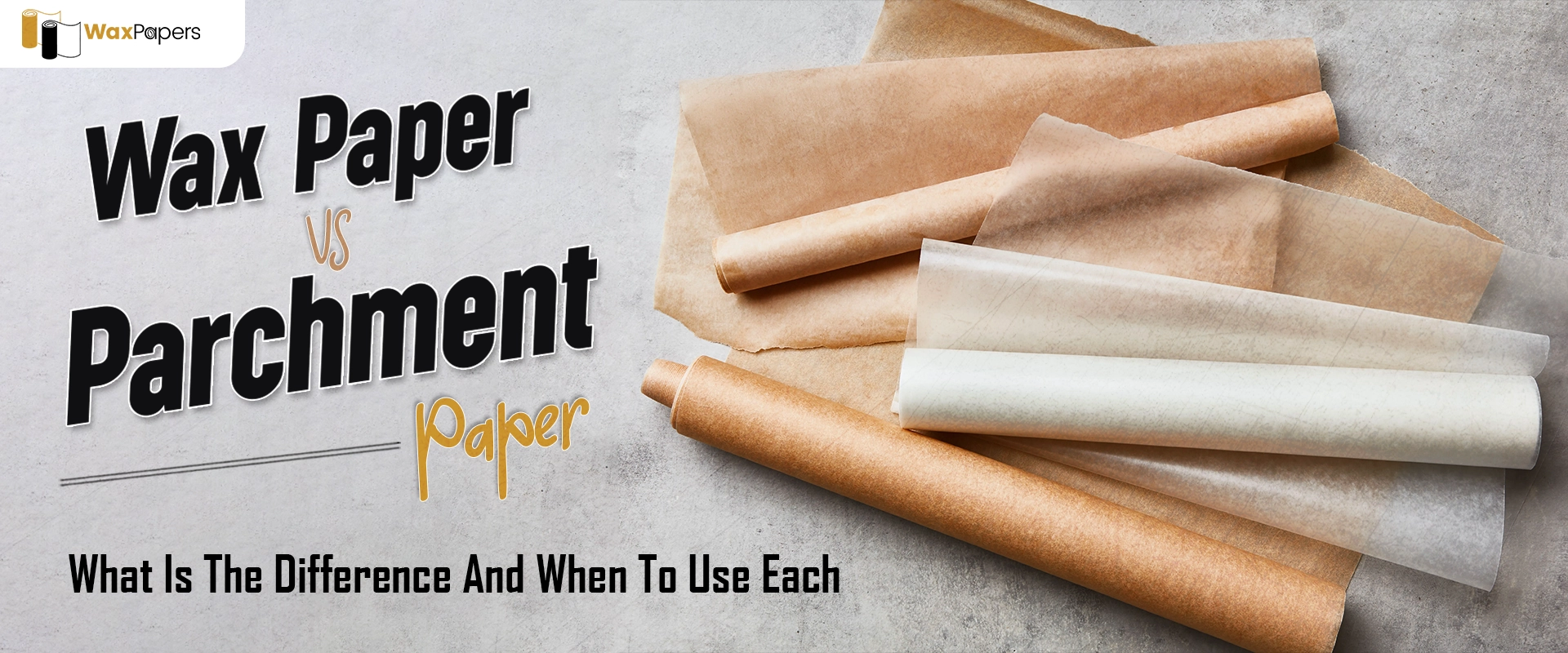Parchment Paper Vs Wax Paper: What Is The Difference And When To Use Each

Has it ever happened to you that you are cooking something? In the middle of the recipe, you are holding parchment paper in one hand and wax paper in the other. You are completely unsure what to use. If you have encountered such a situation, then you are not alone. At first glance, these two look almost similar. Both papers come in sheets and roll form. Not only this, they are placed side by side in baking aisles. All these factors make it difficult to differentiate parchment paper from wax paper.
When it comes to comparing parchment paper vs wax paper, we can find some variations as well after closely analysing the sheets. Some of the key features that create differentiation are as follows:
- Coatings
- Thermal properties
- Minor difference in texture and GSM
- Application
Choosing the wrong paper is not a minor inconvenience; it can lead to soggy food and sticky messes. In serious cases, a fire hazard can also occur in your oven. To help you avoid these mistakes, we have broken down some of the key differences. Let’s read the blog and learn how to differentiate and select an appropriate option.
What Is Parchment Paper?
Parchment sheet is a cellulose-based baking and cooking paper. This paper is typically made from purified wood pulp and undergoes a chemical bath in sulphuric acid or zinc chloride. These chemical solvents partially gelatinize the cellulose fibers and create a dense sheet. This sheet is also smooth and has a stable matrix with low porosity. In addition to this, the thermal and chemical resistance of paper is also enhanced at the end of chemical bathing.
After treating the parchment wrapping paper, it is coated with food-grade silicone. This coating is the hallmark of a non-stick and water-repellant coating. Silicone coating also makes the paper resistant to oil. All these features make it an excellent baking tray liner for high-temperature use. Some of the technical explanations of the key features of parchment rolls and sheets are as follows:
Heat Resistant
The sulphuric acid (or in some cases, zinc chloride) treatment chemically alters the cellulose fibers and makes them thermally more stable and less prone to decomposition at high temperatures. Due to this reason, parchment paper can withstand an oven temperature of around 420 to 450 Fahrenheit without breaking or burning (as long as the paper is not directly exposed to the flames or broilers). This feature makes it ideal for:
- Baking cookies
- Roasting vegetables
- Preparing dishes en papillote
Non-Stick
Aside from making the paper heat resistant, the application of silicone coating gives the sheets a smooth and hydrophobic surface. This hydrophobic surface (water-repelling) has low surface energy, which means most substances can not adhere to it, such as dough or batter, and even melted cheese. You can easily release the food without requiring greasing pans or trays. It also helps to maintain the integrity of the delicate baked items, such as:
- Baking meringues
- Baking cookies and macarons
- Cooking sticky syrups
Moisture And Grease Resistant
Silicone coating not only resists water, but it also blocks the penetration of fats and oils. The non-polar chemical structure is the reason for the blockage of fats and oils. By using the paper, you can prevent liquids from seeping through the surface of parchment paper and reduce the sogginess of baked items while keeping the pans clean. You can perfectly bake:
- Salmon
- Meatballs
- Buttery pastries
Silicone Coated (Not Waxed)
Wax coating melts at a low temperature. On the other hand, silicone coating is thermally stable and chemically inert. That is why it is easily suitable for baking temperatures. Your parchment-wrapped will remain intact and functional even under prolonged heat exposure.
Suitable for Baking and Oven Use
Cellulose and silicone coatings harden due to acid treatment, which allows easy baking and release of food from the paper. When you use parchment paper, you do not have to worry about the transfer of taste to the food because silicone is inert. This also allows the paper to remain stable in dry and moist heat. That is why most of the commercial bakeries use parchment wraps to line the trays and wrap the food during storage.

What Is Wax Paper?
This paper is also made of cellulose. The surface treatment and coatings are the main difference between wax paper and parchment paper. Instead of chemical hardening and silicone coating, a thin layer of paraffin is applied to the paper. For sustainable alternatives, soybean and beeswax can also be used. This wax layer gives the paper sheets a smooth and shiny surface. The same is the reason for moisture and oil resistance.
Wax paper is unsuitable for baking due to its low melting point, at a temperature of 120 to 150 degrees Fahrenheit. This paper can also ignite at high temperatures. Some of the technical explanations of wax-coated paper features are as follows:
Coated With Paraffin Or Soybean Wax
Wax is applied on both sides of the paper with the application of heat and pressure. This created a uniform coating that fills the pores and gives a smooth surface. Wax coating also adds slight flexibility and water-repellent ability to the paper. You can use it for the following purposes:
- Wrapping sandwiches
- Wrapping cheese
- Covering countertops during messy prep work
Moisture-Resistant
Wax coating creates a hydrophobic layer on the paper that repels water and prevents moisture absorption by the paper fibers. You can keep your wrapped food free from sogginess. Wax paper sheets are produced for short-term use at normal temperatures. A slight increase in the temperature can soften or liquify the paper, making it unsuitable for direct heating. It is:
- Best for room temperature or refrigerated applications
- Wrapping cold cuts
- Lining surfaces for chocolate work.
Not Oven-Safe
Paraffin and soybean wax both have low thermal tolerance. When the paper is exposed to high temperatures, the wax will melt. This causes the paper to stick to the food, or in severe cases, the paper can ignite. Some of the damaging situations that can occur are:
- Fire hazards
- Burnt food
- Damaged cookware
Comparing The Usages Of Wax Paper Vs Parchment Paper
| Task | Parchment Paper | Wax Paper |
| Baking Cookies | Oven Safe | Not Suitable |
| Roasting Veggies | Heat Resistant | Wax Melts |
| Lining Cake Pans | Non-stick Base | Unsafe Option |
| Cooking En Papillote | Steam Locks | Not Heat-safe |
| Microwave Use | Splatter Guard | Short Use |
| Wrapping Sandwiches | Overkill Use | Best Choice |
| Storing Candy | Oversticks Prevented | Ideal Liner |
| Rolling Dough | Great Option | Good Option |
| Covering Countertops | Heatproof Sheet | Mess Barrier |
| Freezer Storage | Works Well | Also Works |
Conclusion
Use wax paper only as a substitute when no heat is involved. For anything that involves heat, use parchment paper. When you are in doubt and have no idea what to choose, parchment is the safest option. When you understand the technical features of the papers, you can keep your cooking process safe and efficient. Keep both in the kitchen so that you always have the right choice for the job. For a quality and economical option, you can contact waxpapers.net and get the best option you have ever had.
Beta feature


